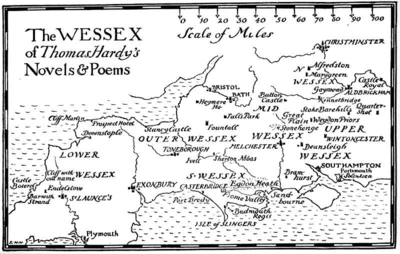Our website is made possible by displaying online advertisements to our visitors.
Please consider supporting us by disabling your ad blocker.
Thomas Hardy's Wessex

Thomas Hardy's Wessex is the fictional literary landscape created by the English author Thomas Hardy as the setting for his major novels,[1] located in the south and southwest of England.[2] Hardy named the area "Wessex" after the medieval Anglo-Saxon kingdom that existed in this part of that country prior to the unification of England by Æthelstan. Although the places that appear in his novels actually exist, in many cases he gave the place a fictional name.[3] For example, Hardy's home town of Dorchester is called Casterbridge in his books, notably in The Mayor of Casterbridge.[4][5] In an 1895 preface to the 1874 novel Far from the Madding Crowd he described Wessex as "a merely realistic dream country".[6]
The actual definition of "Hardy's Wessex" varied widely throughout Hardy's career, and was not definitively settled until after he retired from writing novels. When he created the concept of a fictional Wessex, it consisted merely of the small area of Dorset in which Hardy grew up; by the time he wrote Jude the Obscure, the boundaries had extended to include all of Dorset, Wiltshire, Somerset, Devon, Hampshire, much of Berkshire, and some of Oxfordshire, with its most north-easterly point being Oxford (renamed "Christminster" in the novel). Cornwall was also referred to but named "Off Wessex". Similarly, the nature and significance of ideas of "Wessex" were developed over a long series of novels through a lengthy period of time. The idea of Wessex plays an important artistic role in Hardy's works (particularly his later novels), assisting the presentation of themes of progress, primitivism, sexuality, religion, nature and naturalism.[7][8][9] However, this is complicated by the economic role Wessex played in Hardy's career. Considering himself primarily to be a poet, Hardy wrote novels mostly to earn money. Books that could be marketed under the Hardy brand of "Wessex novels" were particularly lucrative, which gave rise to a tendency to sentimentalised, picturesque, populist descriptions of Wessex[10] (which, as a glance through most tourist giftshops in the south-west reveals, remain popular with consumers today).
Hardy's resurrection of the name "Wessex" is largely responsible for the popular modern use of the term to describe the south-west region of England (with the exception of Cornwall and arguably Devon). Today, a panoply of organisations take their name from Hardy to describe their relationship to the area. Hardy's conception of Wessex as a separate, cohesive geographical and political identity has proved powerful,[11] although it was originally created purely as an artistic conceit, and has spawned a lucrative tourist trade, and even a devolutionist Wessex Regionalist Party.
- ^ Williams, Harold (January 1914). "The Wessex Novels of Thomas Hardy". The North American Review. 199 (698): 120–134. JSTOR 25120154.
- ^ Darby, H.C. (July 1948). "The Regional Geography of Thomas Hardy's Wessex". Geographical Review. 38 (3): 426–443. Bibcode:1948GeoRv..38..426D. doi:10.2307/210904. JSTOR 210904.
- ^ "Map of Thomas Hardy's Wessex". British Library. Retrieved 25 November 2015.
- ^ Birchall, Eugene. "Wessex Place Names". Wessex Photos. Retrieved 25 November 2015.
- ^ "An Introduction To Hardy's Wessex". South Coast Central. Retrieved 25 November 2015.
- ^ "Exploring Thomas Hardy's West Dorset" (PDF). Visit Dorset. Retrieved 25 November 2015.
- ^ Birch, B.P. (1981). "Wessex, Hardy and the Nature Novelists". Transactions of the Institute of British Geographers. 6 (3): 348–358. Bibcode:1981TrIBG...6..348B. doi:10.2307/622293. JSTOR 622293.
- ^ Farrell, John P. (Autumn 2010). "Hardy versus Wessex". The Hardy Review. 12 (2): 126–147. doi:10.1179/193489010X12858552463204. JSTOR 45301021.
- ^ Tait, Adrian (Autumn 2013). "Hardy, Sassoon, and Wessex: The Enduring Appeal of the Immutable". The Thomas Hardy Journal. 29: 140–161. JSTOR 48568997.
- ^ Bennett, Alan (2008). "Hardy's Wessex in Railway Representations". The Hardy Society Journal. 39 (2): 47–60. JSTOR 45274571.
- ^ Kester Rattenbury (February 2018). "The Invention of Wessex". Places Journal (2018). doi:10.22269/180213. Retrieved 20 September 2021.
Previous Page Next Page


